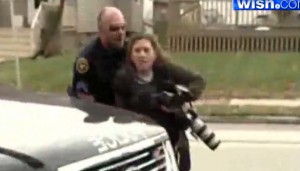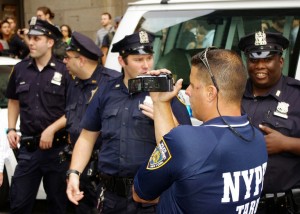Q & A With Photographer Carlos Miller: Media Rights in the Occupy Movement
by Molly Burkett / December 6, 2011 / No comments

(left) An Occupy Portland Protester attacks film crew. (right) Photojournalist Ian Graham is arrested at Occupy Richmond.
Kristyna Wentz-Graff is a photojournalist for Journal Sentinel, a publication out of Milwaukee, Wisconsin. She was arrested on November 2 while covering the Occupy movement at the University of Wisconsin, despite her press pass and photography equipment. She was released the same day without being told why she was arrested.
Wentz-Graff was the second photojournalist to be arrested in Milwaukee this year and one of many journalists to be arrested nation-wide while covering the Occupy movement.
While certain organizations have already taken issue with the arrests of journalists with clear press credentials, photography is protected under the first amendment as a form of freedom of speech.
Photographers have the right to photograph in any public place, including streets, parks, and infrastructures such as subways, bridges, and airports. If a private building or space is visible from a public location, it can be photographed, and if in a public place, subjects do not have to sign a release form. For a more comprehensive account of photographer’s rights read here.
Sampsonia Way contacted Carlos Miller, a photographer, multimedia journalist, and blogger from Miami, Florida via email for his take on the treatment of photographers covering the Occupy movement. In April 2007 Miller founded the website Photography Is Not A Crime after he was arrested for taking photos of police. He has been arrested twice and fought each charge without a lawyer and won his cases.
He created the blog to document ongoing abuses against photographers. Situations like Wentz-Graff’s and other photographers of the Occupy movement have made their way to Miller’s blog, which has become a source for information on photographer’s rights. Miller has also spoken to classes and photography panels about free-expression rights in a digital age.
How would you describe the treatment of photographers during the Occupy movement?
For the most part, the treatment of photographers has been good because most everybody has a camera and most everybody is a photographer. But there have been several issues with the activists confronting videographers, thinking they have some type of expectation of privacy.
This usually happens when the occupiers are not familiar with the videographers, but that is no excuse. It’s just ignorance of the law and it many cases, a blatant attempt of intimidation.
As far as police, several photographers have been arrested, but it has been a very small percentage. That can be attributed to the fact that cops know that their actions are being recorded.
What protection or precautions should photographers who are capturing the protests be aware of?
It’s essential that videographers continue to record, especially in an instance of attempted intimidation.
Are there any legal ramifications if one should be arrested?
Once you get arrested, you have to deal with it until they release you, but if you document your arrest, the footage might serve as evidence to support your innocence.
Do you know anyone who has been arrested and could you describe the process he or she went through?
I don’t personally know anybody who has been arrested during the Occupy protests, but I’ve written several stories on my blog.
Correction, 12/12/2011: Carlos Miller met photographer Alisen Redmond at a journalism conference in Georgia, prior to her November 5 arrest at Occupy Atlanta.






